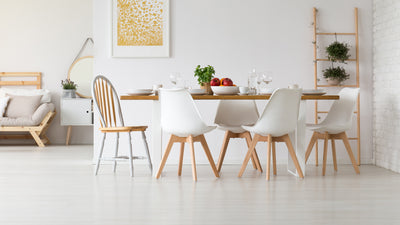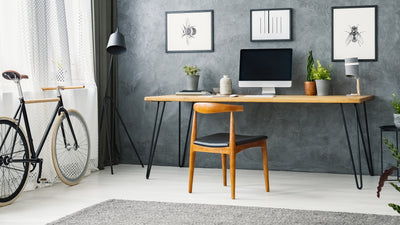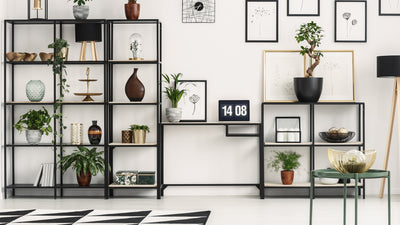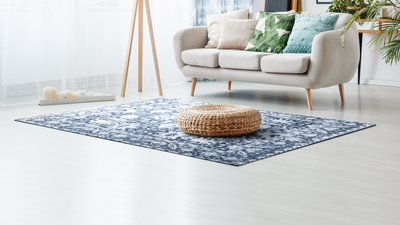How to Choose the Right TV Mount or Stand

Everyone likes a bit of flexibility with their entertainment, and there are few things more flexible than a traditional TV stand...except perhaps a modern, full motion TV wall mount. Luckily for you, Artiss offers both!
You might want to use a TV mount or TV stand for many reasons. Mounts eliminate the need for a TV unit, so you can save on space. They can help you position your TV to your exact viewing requirements, from viewing distance to height. A TV stand from Artiss gives you the flexibility of a wall mount, with the portability of a simple stand. We have models with castor wheels to easily move your television to the required position, static stands that allow you to adjust as you go and leave a minimal footprint, even simple brackets to help keep your TV upright.
If you’re looking for the best TV mounts or TV stands but have no idea where to start, Artiss has you covered with our comprehensive buying guide.
Finding the right space
If you’re planning to mount a television on a wall or stand, you’ll need to consider the same physical limitations as if you were installing a full television unit.
Will a mount or stand fit with your existing furniture? Measure the space where you intend to mount or stand your television. You’ll want to allow for room in case of general maintenance (behind and on each side of the television) as well as room to adjust the screen depending on the range of movement of your mount. You’ll also need to be close to powerpoints, and any other devices you plan on connecting to the television (such as consoles).

The distance from where you’ll be sitting also matters. According to Sony, the recommended viewing distance from a 4k television is 1.5x the vertical screen size: for example, if you have a 43” TV screen, you should sit approximately 90cm away from the screen. This is to prevent eye strain, irritation and headaches. You also need to consider the height of the television. To prevent neck pain, a television should ideally be at or below eye level when sitting down. Of course, mounts allow for all kinds of configurations - just take into account your most comfortable viewing position before you mount it to the ceiling!
Technical specifications
Where you can mount your television will also depend on your walls. Almost all television mounts will be compatible with plasterboard, but if you have a brick or concrete wall you may need more specialised equipment and fittings.
When mounting on plasterboard, you’ll want to secure your mount to wall studs. You can find these by knocking on the wall and listening for when the knock changes or you can use a stud finder. You'll also have to be aware of any electrical connections in the wall, which can be found using your home plans or with a specialist stud finder. For brick and concrete walls, you can use wall plugs. If you have any doubts about this process, seek out a professional - a bad wall mount is dangerous and can damage your wall, television and anything below, and may cost more than the money you saved doing it yourself.

Choosing the right mount
Compared to other furniture pieces, TV mounts and stands may have less variety in their styles, but they are incredibly flexible when it comes to positioning your television. If you have a small living room or you want a television that can be put away at a moment's notice, you've come to the right place. There are mounts available from floor to ceiling, and you’ll easily find the right one for your television or monitor thanks to the VESA interface system.
What is the VESA interface standard?
There is almost no end to your options for TV mounting with the VESA interface standard adopted by most TV brands. But what exactly is a VESA interface standard, and how does it help you choose the right mount?
The VESA interface standard defines a set distance between the four mounting holes at the back of a television. It is an industry standard adopted by most television manufacturers, so you can rest assured you’ll find the perfect TV mount or stand for your exact needs.

You should be able to find your television’s VESA size in the product description or manual, or you can simply measure it. Measure the mounting holes from left to right, then top to bottom, to find your exact VESA measurements. For example, a television that measures 400mm left to right and 300mm top to bottom will have a VESA size of 400x300.
Weight capacity
You’ll need to check whether the wall mount or stand can hold the weight of your television before buying. You should be able to find this in the product specifications.
Types of wall mounts
Fixed wall mounts brackets
Fixed wall mount brackets are designed to keep the TV as close to the wall as possible and have little to no mobility. While you can still adjust them before installing, once they are in place they are not going anywhere!
Tilting wall mount brackets
Tilting wall mount brackets are ideal for reducing glare and reflections. They don’t offer a full range of motion, just enough to keep the screen clear on a sunny day. Perfect for the lounge room with large windows and sheer curtains.
Full-motion wall mount brackets
Full-motion wall mount brackets offer the most flexibility for your television. They can be expanded or retracted, tilted in any direction, and some models even allow you to turn it completely upside down. Perfect for flexible viewing or for mounting in corners.
Corner mounting
While full-motion wall brackets can be used for corner mounting, you can also get wall mounts with dual brackets that straddle a single corner. This provides additional support and may make it easier to place the tv closer to the wall for a more fitted look and feel, but are not essential to a safe and practical wall mount.
Ceiling mount brackets
Ceiling mount brackets are perfect for those without an inch of wall space. They mount to the ceiling and allow the TV to hang, and usually come in a wide range of motion. These are perfect for commercial and office settings as well as the home.
Types of TV stands
Tabletop
These stands may be comprised of two feet or a single platform and are designed to hold the TV upright on a tabletop. They have less storage compared to an entertainment center but still have plenty of room for both the television and some consoles, set top boxes, sound systems, and any other electronics you may need at hand.
Fixed floor
These TV stands are designed to sit in one place. They may have a flat bottom, and they may come with a small amount of storage space. The TV is able to be adjusted, but the stand is designed to sit firmly in place.
Portable
These TV stands usually come on castor wheels and can be moved from room to room as required. They may come with a small amount of storage. These are great for homes that don’t always use their TV because it can be moved our of the way for more floor space, but they are also good for schools or commercial spaces that only sometimes require a screen.
Materials and styles
TV mounts do not have the same variety of materials as other TV accessories. They have to be able to carry the entire weight of a flat screen, so they need to be made out of high-quality, high-weight-capacity materials. Most TV wall mount brackets will be constructed out of high-grade, reinforced steel or iron. Sometimes this metal is powder-coated, which makes it resistant to rust and corrosion while also giving it a smooth, aesthetically pleasing appearance.
TV stands that include mounting brackets are usually extensions of the same metal, as they need to be strong enough to hold the TV monitor. Some stands may use tempered glass or similarly solid materials for their storage, as this is also a strong and high-weight-capacity material.
Because of these limitations, there are limited styles available for TV mounting brackets and stands. There is less focus on aesthetic appeal and more emphasis on functionality. But that doesn’t mean you won’t be able to find an ideal style for your home. Black TV stands suit minimalist, industrial-style homes that already place practicality over style, and the unobtrusive designs blend well into corporate, commercial and educational settings.
Should I buy a TV mount, TV stand or entertainment unit?
A TV stand does more than just hold TVs. They are specifically designed to draw the eye, keep your collection in a single place, tie together your interior design, and allow you to watch TV from a comfortable position. How you choose to display your television will depend on your lifestyle.
An entertainment unit or TV unit can be an attractive focal point and has more than enough storage for all your books, electronics, gaming consoles, toys or decorations. There are models in all different shapes and sizes, so you can find entertainment units to suit any kind of room. Even if you have an entertainment unit, you may find yourself mounting the television to the wall as well - a mounted television can be adjusted for viewing and is much safer if you have small children or pets, as a wall-mounted television is less likely to be pulled or knocked down.
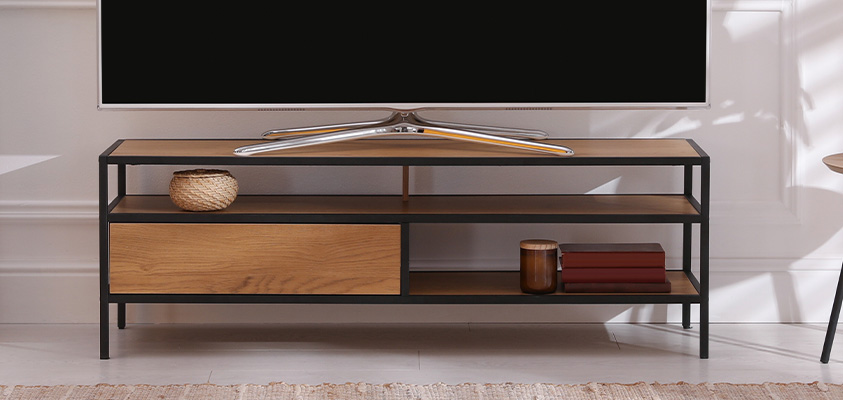
Wall mounting a TV is the most flexible option, as you can mount it almost anywhere and adjust the television as you see fit. It has a clean look that is perfect for minimalist homes. The drawback is that there is obviously no storage space and no cable management system, so you’ll have to find your own way of keeping cables out of the way. As TV stand alternatives go, full-motion TV wall mount brackets are one of the best ways to save space, make room for your home decor, and stay flexible enough to reach everyone's most comfortable viewing angle.
A TV stand is a great mix of the two. Though the terms have been used interchangeably, we define our TV stands as units with built-in mounting brackets. These stands may come on wheels and can be height adjustable, so you have the flexibility to find your ideal viewing height and the portability to move the TV from room to room as you please. Cable management is easier and some models come with space for storage. Other models are more basic, simply acting to keep your television upright. Whether you're after extra storage space or just want something simple, minimalist and affordable, our TV stands are ideal.
Should I mount my television myself?
Wall mounting a television is a simple process, but that doesn’t always mean you should do it alone. Here are some things to consider if you want to DIY your new wall mounting bracket:

-
If this is your first time mounting a television, we recommend hiring a professional. They will bring the right tools for the job, and they will know what to do if something goes wrong. Remember, a television is a heavy object. Incorrect mounting will not only look bad, but a falling TV has the potential to damage your surrounding furniture as well as your unsuspecting family members.
-
Never do it alone! Televisions are heavy, awkward and unwieldy. You should always have someone else with you to help lift heavy equipment, TV or otherwise.
-
Check your product manual and specifications on how to handle your television. Flat screens are especially delicate and should be handled with care to avoid cracking. Avoid putting your hand directly against the glass.
-
While Artiss includes all the fixings you need for easy installation, you will still need power drills and other handheld tools to make holes, secure screws, and other parts of the mounting process.
Should your TV stand be wider than your TV?
Yes. Experts recommend that your tv stand should be at least 3 to 6 inches wider or longer than your television. The main reason for this is safety - you don't want your TV to fall over onto unsuspecting family members or pets. A wider base means more stability, which is especially important for larger TVs. The second reason is style. When the TV is smaller than the stand, it's a lot more visually appealing than if the TV is hanging over the edge. Overhanging edges are also at higher risk of being cracked, shoved or bumped.
Of course, this isn't a hard and fast rule. When the television is mounted to the stand, as with many of the stands offered by Artiss, the weight issue becomes a lot more manageable. Placing your television against a wall also mitigates the risk of being knocked over. It is also just a reality of modern entertainment that many screens are much larger than the available stands. Make sure you follow the weight restrictions outlined by the manufacturer for both your television and stand.
Where is the best place to put a TV in the living room?

When placing your TV in the living room, there are a few things to consider. You don't want your television somewhere it might be tipped over or bumped into, which is why against a wall is usually a safe spot. If you're using a tv wall mount bracket, you'll be limited by your internal stud placement (depending on your wall materials). You'll need to account for glare from any surrounding windows - you may want to test your preferred placement at different times of day. You'll also need to account for height - your television should be placed at eye level to comfortably watch your favourite movies and shows. If flexibility is important for you, there are full motion mounts that give you the sleek look of a floating TV and more free floor space, or you can buy a TV stand on wheels for the ultimate in-and-out flexibility.
Buy TV mounts and stands online
Artiss has a wide selection of TV wall mount options to suit your lifestyle and budget. Whether you are making your home safer for your family, or simply creating a cleaner, less cluttered entertainment experience, we have you covered with our extensive collection of mounts and stands. Thanks to our reliable courier partners, your package should arrive within 3-8 business days so you don’t have to wait for your entertainment. Our prompt and friendly customer service representatives are always here to help with any issues, so you can rest assured you will be taken care of.
For more information about our TV entertainment units, check out our blog post How To Choose The Right TV Unit.
Browse our collection and start planning for your new TV stand or wall bracket today!





